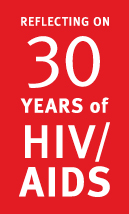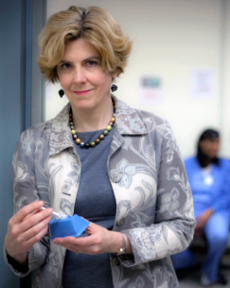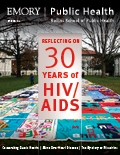The Fabric of Hope
By Pam Auchmutey
The enormity of it can hit quite suddenly.
|
|
The 1,200 panels of the AIDS Memorial Quilt displayed at Emory on World AIDS Day represent only a portion of the 40,000 panels stitched to honor more than 91,000 men, women, and children who have died since the quilt was conceived in 1985.
James Curran, dean of the Rollins School of Public Health, has seen the quilt displayed on the quadrangle at Emory, at the football dome in Minneapolis, and on the mall in Washington, D.C.
“When you pause by the quilts, you realize these people had one thing in common,” says Curran. “They were no longer gay or straight, black or white, Hispanic or Asian, men or women. For every quilt panel, there was a person who died of AIDS. Collected together, the quilt panels represent an epidemic.”
In the United States, the CDC estimates, more than 18,000 people with AIDS die each year. Nearly 600,000 Americans have died since the epidemic began in 1981. Globally, 33.3 million people are infected with HIV. Of those, 22.5 million live in sub-Saharan Africa, where AIDS is the leading cause of death among adults.
HIV frequently strikes those who can least afford it, widening the gap in health disparities. In Atlanta, substance abuse is a major driver of HIV infection. One of the highest concentrations of AIDS is found in the Southeast, where poverty, stigma, and limited access to care are factors.
While the numbers are staggering, scientists, health experts, and policy makers have made steady progress against the disease for three decades: Establishing the epidemiologic pattern of AIDS and its distribution throughout the world. Identifying the mode of transmission—blood, mother to child, and sexual intercourse. Isolating HIV and proving that it caused AIDS. Implementing diagnostic tests and screening blood donors. Introducing combination therapy—the AIDS cocktail. Proving that male circumcision and condom usage could prevent infection. And continuing the pursuit of the holy grail—developing a safe and affordable vaccine.
In the absence of a vaccine, prevention remains key. Each day, more than 7,000 people worldwide acquire HIV, totaling 2.7 million cases annually and including 56,000 cases in the United States.
Understanding which preventive measures work best for individuals and populations is paramount. The AIDS Memorial Quilt makes for a good starting point. Behind the name of every loved one are scientists, clinicians, and public health experts searching for answers.
|
Online: Listen as Emory researchers reflect on 30 years of HIV/AIDS at |
||||
JAMES CURRAN - Leading the Charge
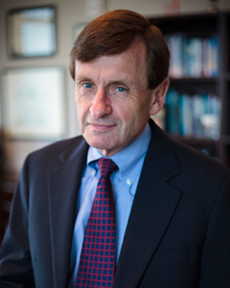
James Curran has spent 30 years studying HIV/AIDS at the CDC and Rollins. |
The two men had much in common. They grew up in the Detroit area, attended rival high schools, and received Ivy League educations. At 36, both led full lives—one was an entertainer, the other a CDC epidemiologist. They met in June 1981 at a New York City hospital, where the performer was being treated for Kaposi’s sarcoma, a rare form of cancer.
“I remember him. He was a smart kid,” says James Curran of the first patient he met with AIDS.
It was a troubling encounter since no one knew why the man was fatally ill. Curran had gone to New York to investigate the Kaposi’s outbreak among healthy homosexual men. The subsequent case definition for disease surveillance put in place by Curran’s CDC team was adopted worldwide, allowing early and consistent recognition of the global AIDS epidemic.
Three decades later, Curran remains one of the world’s leading experts on the disease. After joining Rollins as dean in 1995, he and other Emory experts formed an AIDS interest group to share ideas. That group gave rise to the Emory Center for AIDS Research (CFAR) to coordinate and grow HIV/AIDS science. Today, the Emory CFAR has 150 investigators and $70 million in annual funding from NIH and other sources. Curran leads the charge as one of three co-directors and principal investigator.
Administratively based in the RSPH, the Emory CFAR emphasizes prevention—health education, risk reduction among adolescents and adults, development and testing of HIV vaccines and behavioral interventions, and prevention and treatment of retroviral infections and tuberculosis to prevent complications from these diseases. CFAR investigators conduct training and research locally and nationally and in Africa, India, and Eastern Europe.
Today, Curran would have much to offer the patient in New York. “I would tell him that we know the disease is caused by a virus, HIV, and there are good therapies for treatment,” says Curran. “He would have to take drugs every day but would live a long and fairly normal life. And he would have every reason to be optimistic.”
CARLOS DEL RIO - Multiplying Research Capital
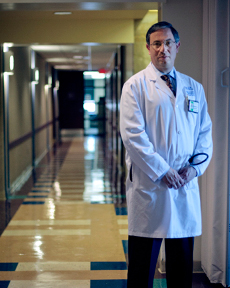
Carlos del Rio was a medical resident at Grady Memorial Hospital in the early days of the AIDS epidemic. |
Carlos del Rio has a soft spot for heroes. In junior high, he admired scientists like Louis Pasteur, who developed vaccines to combat infectious disease. During his medical residency at Emory in the early 1980s, del Rio idolized physician Sumner Thompson, who fought to open a clinic at Grady Memorial Hospital to serve the growing number of Georgians with HIV.
Since his days as a physician in training, del Rio has worked to reduce the spread of HIV on multiple fronts—leading the National AIDS Program in his native Mexico, caring for patients at Grady, directing the NIH-sponsored HIV Prevention Trials Network at Emory, advising U.S. agencies on HIV prevention and care, and growing global capacity for HIV research. Del Rio, Hubert Professor and chair of the Hubert Department of Global Health, also co-directs the Emory Center for AIDS Research and leads the Emory AIDS International Training and Research Program (AITRP).
Through AITRP, young investigators from Georgia, Mexico, Rwanda, Vietnam, and Zambia are trained in public health and in basic, clinical, and behavioral and social sciences. The program is supported by the NIH’s Fogarty International Center to advance health through scientific cooperation worldwide. Specifically, the grant allows promising young investigators to study at Emory or at partner institutions abroad to strengthen HIV/AIDS research in their respective countries. More than 220 trainees have benefitted from the Emory AITRP since 1998.
“Approximately 97% of people with HIV live in low- and middle-income countries,” says del Rio. “One key thing Emory can do is train the next generation of researchers and leaders in some of those countries. AITRP builds human capital and scientific capacity to stop the transmission of HIV.”
ERIC HUNTER - Taming Transmission
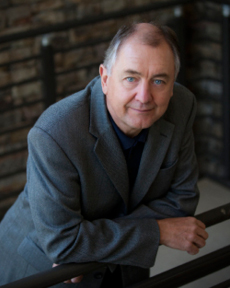
Eric Hunter is an expert on the class of viruses that includes HIV. |
As a young scientist, Eric Hunter believed that the retroviruses known to cause cancer in animals eventually would be found in humans. “But I never thought we would be looking at a global epidemic,” says Hunter, a leading expert on the class of viruses that includes HIV.
In his laboratory at the Yerkes National Primate Research Center, Hunter studies how HIV enters cells. He also collaborates with Emory pathology professor Susan Allen to study HIV transmission among discordant HIV couples (one infected, one not) in Africa. Her seminal studies in Rwanda and Zambia have shown that voluntary counseling, testing, and condom use reduce transmission as much as 75%. The cohort also allows Hunter to study how the virus behaves when one partner infects another.
“There are few cohorts in the world that allow you to study HIV transmission and identify newly infected partners at the very earliest stage of their infection and know where the virus came from,” says Hunter. “The results of our work on these newly infected persons and their infecting virus gives us hope in understanding how HIV-1 initiates infection and how to direct vaccines against it.”
Hunter, a Georgia Research Alliance Eminent Scholar, co-directs the Emory Center for AIDS Research (CFAR). Last fall, he presided over the AIDS Vaccine 2010 Conference in Atlanta, hosted by the Emory CFAR and the Global Vaccine HIV Enterprise.
The mood among the 1,100 participants was upbeat. At the 2009 conference in Paris, researchers announced that a vaccine trial in Thailand yielded a 31% protection rate against HIV acquisition. New discoveries presented in Atlanta showed that generating an immune response to neutralize different HIV strains might be feasible. Says Hunter, “That was important for people to hear—that it’s not impossible to shut this virus down.”
CLAIRE STERK and KIRK ELIFSON - Navigating Everyday Life
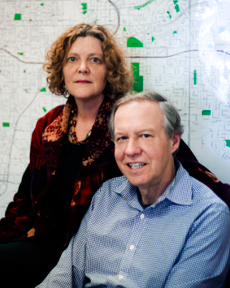
Claire Sterk and Kirk Elifson are looking at factors in Atlanta neighborhoods that contribute to HIV risk. |
Claire Sterk and Kirk Elifson are familiar figures in Atlanta’s poorer neighborhoods, where they work with people at high risk for HIV. They learn from individuals both young and old. And they have seen firsthand that the world can be a lonely place for those who change their behaviors to be more healthy.
“They feel isolated. They no longer fit in with their friends,” says Sterk, Emory senior vice provost for academic affairs and Charles Howard Candler Professor of Behavioral Sciences. “Their social network is no longer a good match, and their neighborhood doesn’t feel the same. That started us thinking about HIV/AIDS in the context of everyday life and the environment in which people live.”
The hub for Sterk and Elifson’s work is a storefront in Atlanta’s West End, where staff and students continue to build on HIP (Health Intervention Project), now widely used by the CDC to help African American women adopt healthy behaviors. The researchers are halfway through a study looking at health-related issues in 100 Atlanta neighborhoods in collaboration with residents, social service agencies, police, architects, and city planners. By talking with residents, they are learning and mapping what each neighborhood needs to improve health—from opening a health care clinic in a convenient location to cleaning up lots left vacant by the economic downturn.
“When you create a better environment, people feel safe in their neighborhoods,” says Sterk. “ And when you feel safe, you can better stand up for yourself. That includes avoiding those behaviors that cause HIV.”
PATRICK SULLIVAN - In a Different Light

Patrick Sullivan (right) confers with doctoral students Eli Rosenberg and Kristin Wall. |
Patrick Sullivan was a teenager when AIDS became a household word associated with gaunt images of people in the late stages of disease.
Younger generations now see AIDS differently. “We think of it as a disease that’s chronic and not curable but manageable,” says Sullivan, a Rollins epidemiologist specializing in HIV prevention and health disparities.
In an Atlanta study, Sullivan is examining the difference in HIV prevalence among black and white men who have sex with men (MSM). While black MSM tend to have fewer casual sex partners, they have two to three times the HIV rate of white MSM. Sullivan is looking at sexual partner characteristics, social networks, stigma, and poverty to understand how they may drive disparities.
Eli Rosenberg, a doctoral student, has begun a related study to learn more about the social networks of black and white MSM. Kristin Wall, a PhD student who has studied HIV in Africa, recently published a paper with Sullivan on HIV testing provided to MSM by their health providers. Wall found that MSM who disclosed their sexual partners were more likely to be offered HIV testing by their doctor. The next step in her research is intervening with health care providers so they routinely ask for sexual histories and offer HIV screening.
The factors that drive HIV acquisition are complex, requiring new approaches to prevention and young inquiring minds to generate them. “Managing epidemics is complicated, even with great tools,” says Sullivan. “We will be talking about this 30 years from now.”
A POWERFUL ENGINE - See CFAR Run
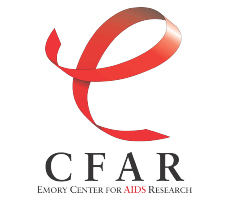
|
Kimberley Hagen, Shelle Bryant, and Judy Catasein are the go-to experts on the Emory Center for AIDS Research (CFAR). Funded by NIH since 1998, CFAR encompasses the RSPH and the schools of medicine and nursing, Yerkes National Primate Research Center, the Emory Vaccine Center and the Hope Clinic, the Atlanta Veterans Affairs Medical Center (VAMC), Emory University Hospital (EUH) Midtown, and the Ponce de Leon Center, an outpatient clinic operated by Grady Health System. The 8,000 patients treated annually at the Ponce Center, EUH Midtown, and the VAMC constitute one of the largest concentrations of HIV/AIDS patients in the country.
The Administrative Core helps CFAR’s wheels turn daily. For example, Bryant and Catasein assisted with planning and logistics for the AIDS Vaccine 2010 Conference in Atlanta, and once a month, Hagen organizes the Vaccine Dinner Club (VDC), a popular speakers program with more than 2,000 members. On World AIDS Day, Kevin DeCock, director of the CDC’s Center for Global Health and former director of HIV/AIDS at WHO, spoke to a packed house of VDC members and guests.
DENNIS LIOTTA and RAYMOND SCHINAZI - Searching for Normal

Dennis Liotta and Raymond Schinazi developed two highly successful drugs to treat HIV. |
Two Emory researchers are credited with a miracle, having developed two of the antiretroviral drugs used by more than 90% of the people in the United States and by many around the world who are on medication for HIV/AIDS.
In the early 1990s, chemistry professor Dennis Liotta, virologist Raymond Schinazi, and researcher Woo-Baeg Choi co-developed the molecules 3TC and FTC, which help prevent or delay HIV from infecting other cells. With time, the WHO recommended FTC or Emtriva (the “Em” stands for Emory) and 3TC (Epivir, also used to treat hepatitis B) as part of a drug treatment regimen for HIV/AIDS. Ultimately, Emory sold the royalty rights to Emtriva, one of the largest such sales in higher education. Atripla, a combination of Emtriva and two previously approved drugs, now enables many patients to take just one pill a day, instead of the handful of pills required 10 years ago.
Emory continues to be a top leader in drug discovery. In 2011, a study in the New England Journal of Medicine named it as the nation’s fourth-largest contributor to the discovery of new drugs and vaccines by public-sector research institutions.
What drives the scientists behind Emory’s HIV/AIDS research? As Schinazi has said, “It’s all about taking people who are dying, abandoned, and condemned, and with these new drugs, allowing them to have normal lives.”—Mary J. Loftus
GINA WINGOOD - Women and Safe Sex
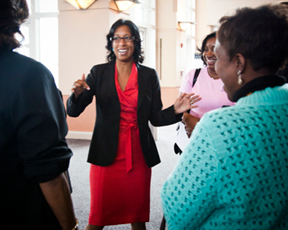
Gina Wingood works with African American congregations in the Atlanta area to inform women about reducing HIV risk through safe sex. |
Ralph DiClemente first encountered AIDS when a close friend died of the disease long before health experts knew how to treat or prevent it. Today, DiClemente, Charles Howard Candler Professor of Behavioral Sciences, and Gina Wingood, the Agnes Moore Faculty in HIV Research, have developed model programs to reduce the risk of HIV and other sexually transmitted diseases (STDs) among teens and young adults. One of their most successful efforts is SISTA (Sisters Informing Sisters about Topics on AIDS), used across the country to encourage young African American women to act responsibly when it comes to sex. The researchers have designed other interventions to guide African American teens and their parents, women in rural South Africa, sex workers in Armenia, adolescents in the Caribbean, and Latina women in Miami.
Currently, DiClemente is reaching out to girls in juvenile detention and women who use alcohol to reduce their risk of HIV and other STDs. Wingood is partnering with large African American churches around Atlanta to reduce women’s risk of HIV across the life span and promote HIV testing. “Churches are highly respected within the African American community,” says Wingood. “They are an important venue to inform women about HIV protection and safe sex.”
SANDRA THURMAN - A Place on the Map
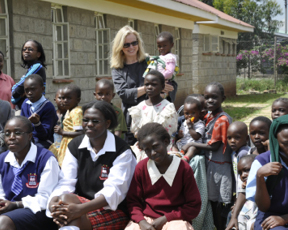
Sandra Thurman calls Africa her second home, where Rollins’ interfaith health experts collaborate with community leaders in Kenya’s Mukuru slum to prevent HIV. |
Less than 10 miles from Nairobi, the Mukuru slum teams with life. Though lacking in electricity and running water, Mukuru has a vibrant network of 17 villages and community leaders. But on any map of Kenya, this town of 600,000 people does not appear. Together, Rollins’ Interfaith Health Program (IHP) and Mukuru citizens are putting it on the map.
Using global information systems technology and community manpower, IHP staff have identified 282 sites thus far to create a directory of health services. “What this does is give us the information to create a community-led response to HIV/AIDS,” says IHP director Sandra Thurman.
Based in the Hubert Department of Global Health, the IHP partners with the Joseph W. Blount Center for Health and Human Rights, which works with underserved populations, primarily in Africa. Thurman also leads the International AIDS Trust (IAT), an extension of her health policy work in the Clinton administration.
Just recently, the IAT produced a film on orphans in Romania who were infected with AIDS during the late 1980s. Thurman also organized the AIDS Legacy Project to document community response to the epidemic in Atlanta and other cities during the 1980s. The archive will be housed at Emory’s Woodruff Library. Thurman and the IHP staff will continue working with Mukuru to build health capacity that is self-sustaining.
“We can’t underestimate the importance of people understanding where they are on the map and where they are in the world,” says Thurman.
AIDS IN AFRICA
Several Rollins researchers work on HIV/AIDS in Africa. Kate Winskell coordinates Scenarios from Africa, involving children, adolescents, and young adults who develop ideas for short films to educate others about HIV/AIDS. African directors have developed winning ideas into 37 short fiction films and a documentary, shown in up to 28 languages. Recently, Rob Stephenson launched a project in Cape Town, South Africa, to provide voluntary counseling and testing for gay couples in a safe, neutral environment.
FRANK WONG - Starting the Conversation
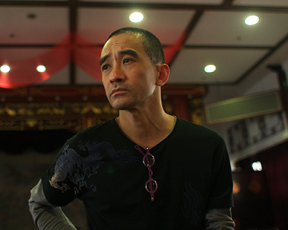
Frank Wong studies the social barriers that put men at increased risk of HIV in China. |
Numbers can be deceptive. In China, less than 1% of the country’s 1.3 billion people are HIV positive. “But when you look at specific subpopulations, the HIV rate is very high,” says Frank Wong, associate professor of behavioral sciences and health education.
Wong’s research focuses on men who have sex with men (MSM), a subgroup that accounts for 5% of HIV cases in China. In urban areas like Shanghai, Wong’s ongoing studies of MSM—of whom half are prostitutes—shows an HIV rate of 8%. Through his research, Wong is addressing the stigma and social barriers that put MSM, gay and straight and including married men, at risk for HIV. Study participants are tested and counseled on prevention and treatment. He plans to use the results to broaden governmental and cultural acceptance of MSM and other groups with HIV.
His study has yielded an unexpected finding: a pattern of intimate partner violence (IPV). He and RSPH colleague Kristen Dunkle plan to study this behavior further among MSM in China and South Africa, where Dunkle’s research has shown a link between IPV among heterosexual couples and increased risk of HIV.
For Wong, the most important weapon in confronting HIV/AIDS is starting a conversation. “I don’t know of any other disease in modern history that would allow people to talk so openly about their sexuality,” he says. “We’ve got to talk about it, no matter how difficult.”
THE HUMPHREY FELLOWS - Scenarios from the Field
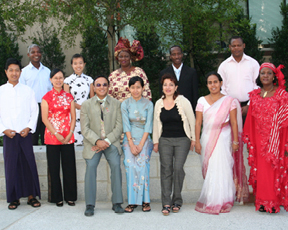
Emory offers a concen-tration in HIV/AIDS for the Hubert H. Humphrey Fellows, who practice what they learn in their respective countries. |
Each year at Rollins, mid-career professionals from around the world take part in the Hubert H. Humphrey Fellowship Program. President Jimmy Carter established the program in 1978 to honor the late vice president for his long-time advocacy of international cooperation. Emory is one of 15 U.S. campuses that host Humphrey Fellows in a variety of disciplines. To date, 175 fellows have studied at Emory since 1993.
Emory has offered a concentration in HIV/AIDS since 2004. Of the 12 fellows studying at Rollins this year, 10 are focusing on the epidemic. After a year of study, these fellows will return to their respective countries—Burma, China, Liberia, Nigeria, South Africa, Sri Lanka, Turkmenistan, Zambia, and Zimbabwe—to practice what they have learned as administrators, clinicians, educators, policy experts, and human rights activists. “We are living in a world where AIDS will be with us for the rest of our lives,” says physician Qi Li, a 2011 Humphrey Fellow from China.
ANNE SPAULDING - HIV and Prison Populations
|
Anne Spaulding leads a project to evaluate rapid HIV testing in Atlanta’s Fulton County Jail. |
If all Atlanta-area jails were combined into one, it would be the third largest in the nation. While the thought is daunting, Anne Spaulding sees an opportunity to reduce HIV risk in a vulnerable population. Through a cooperative agreement with the CDC, Spaulding leads a project to implement and evaluate rapid HIV testing in the Fulton County Jail. Results thus far show an HIV infection rate of over 2%, more than the 1.8% rate among entrants to Georgia prisons.
“Someone described rapid HIV testing in jail as a match made in heaven,” says Spaulding, assistant professor of epidemiology. “We expect the data to show that it is a very fruitful place to detect previously undiagnosed cases. And we can have a larger impact on the community when these people are released.”
She also leads a multi-year project to evaluate 10 national sites that link HIV-positive detainees with health services after they leave jail. Last year, she helped broker an agreement with the Georgia Department of Corrections, jails, prisons, and community clinics to promote sharing of health information for HIV-positive detainees who move among correctional facilities or re-enter the community.
“We must do everything we can for the prison population to make up for the deficiencies in our health care system,” says Spaulding.
PAULA FREW - Community Trust
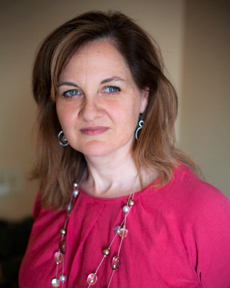
Paula Frew has forged strong ties in the Atlanta community to build trust in HIV clinical trials. |
When Paula Frew 01MPH first saw the Hope Clinic in 2001, the modest building in nearby Decatur had been gutted and dirt covered the floor. Small in size but large in scope, the facility has since earned an international reputation as the clinical trials arm of the Emory Vaccine Center. Key to the clinic’s success are the ties that Frew has formed with Atlanta-area communities, especially those who traditionally are under-represented in HIV clinical studies. They include black men who have sex with men, minority women from low-income neighborhoods, transgender individuals, and African and Asian refugees. Beliefs, behaviors, and attitudes regarding HIV prevention and testing vary within these communities. In many instances, HIV risk is tied to poverty. Through her research, Frew has developed new models for involving communities in clinical trials by tailoring recruitment messages to specific groups, overcoming mistrust about vaccine safety, and reducing HIV risk through education and promotion of economic stability.
“We’re doing everything we can to keep HIV on the community radar,” says Frew, director of health communications and applied community research for the Hope Clinic. “We want to raise awareness so that different groups can take ownership of preventing HIV. By heightening awareness of what that means to them, we’re halfway there to getting them to enroll in clinical trials.”

